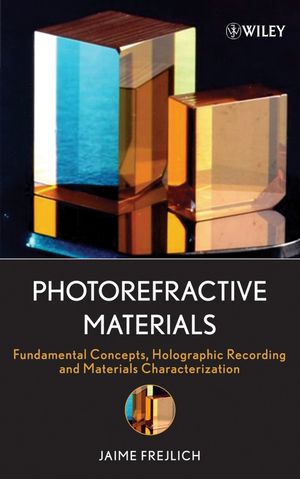Photorefractive Materials: Fundamental Concepts, Holographic Recording and Materials CharacterizationISBN: 978-0-471-74866-3
Hardcover
336 pages
November 2006
 |
||||||
LIST OF TABLES.
PREFACE.
ACKNOWLEDGMENTS.
I FUNDAMENTALS.
1. ELECTRO-OPTIC EFFECT.
1.1 Light propagation in crystals.
1.2 Tensorial Analysis.
1.3 Electro-optic effect.
1.4 Concluding Remarks.
2. PHOTOACTIVE CENTERS AND PHOTOCONDUCTIVITY.
2.1 Photoactive centers: Deep and shallow traps.
2.2 Photoconductivity.
2.3 Photochromic effect.
II HOLOGRAPHIC RECORDING.
3. RECORDING A SPACE-CHARGE ELECTRIC FIELD.
3.1 Index of refraction modulation.
3.2 General formulation.
3.3 First spatial harmonic approximation.
3.4 Steady-state nonstationary process.
3.5 Photovoltaic Materials.
4. VOLUME HOLOGRAM WITH WAVE MIXING.
4.1 Coupled wave theory: Fixed grating.
4.2 Dynamic coupled wave theory.
4.3 Phase modulation.
4.4 Four-wave mixing.
4.5 Final remarks.
5. ANISOTROPIC DIFFRACTION.
5.1 Coupled wave with anisotropic diffraction.
5.2 Anisotropic diffraction and optical activity.
6. STABILIZED HOLOGRAPHIC RECORDING.
6.1 Introduction.
6.2 Mathematical formulation.
6.3 Self-stabilized recording in actual materials.
III MATERIALS CHARACTERIZATION.
7. NONHOLOGRAPHIC OPTICAL METHODS.
7.1 Light-induced absorption.
7.2 Photoconductivity.
7.3 Electro-optic coefficient.
8. HOLOGRAPHIC TECHNIQUES.
8.1 Direct holographic techniques.
8.2 Phase modulation techniques.
9. SELF-STABILIZED HOLOGRAPHIC TECHNIQUES.
9.1 Holographic phase shift.
9.2 Fringe-locked running holograms.
9.3 Characterization of LiNbO3:Fe.
IV APPLICATIONS.
10. VIBRATIONS AND DEFORMATIONS.
10.1 Measurement of Vibration and Deformation.
10.2 Experimental Setup.
11. FIXED HOLOGRAMS.
11.1 Introduction.
11.2 Fixed holograms in LiNbO3.
11.3 Theory.
11.4 Experiment.
V APPENDICES.
A DETECTING A REVERSIBLE REAL-TIME HOLOGRAM.
A.1 Naked-eye detection.
A.1.1 Diffraction.
A.1.2 Interference.
A.2 Instrumental detection.
B DIFFRACTION EFFICIENCY MEASUREMENT: REVERSIBLE VOLUME HOLOGRAMS.
B.1 Angular Bragg selectivity.
B.1.1 In-Bragg recording beams.
B.1.2 Probe beam.
B.2 Reversible holograms.
B.3 High index of refraction material.
C EFFECTIVELY APPLIED ELECTRIC FIELD.
D PHYSICAL MEANING OF SOME FUNDAMENTAL PARAMETERS.
D.1 Debye screening length.
D.1.1 Temperature.
D.1.2 Debye screening length.
D.2 Diffusion and mobility.
E PHOTODIODES.
E.1 Photovoltaic regime.
E.2 Photoconductive regime.
E.3 Operational amplifier operated.
BIBLIOGRAPHY.
INDEX.



